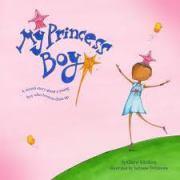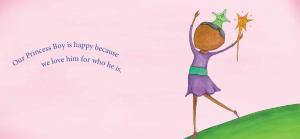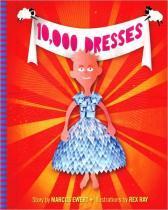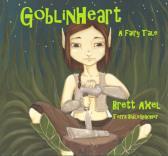Content warning. Some brief transphobic language appears below (for illustrative purposes only).
There are comparatively few picture books on the market that feature characters questioning or struggling with their gender identity or experimenting with their gender expression. Frequently recommended are books about feeling ‘different’, such as 70′s favourite Oliver Button is a Sissy, but feeling different can present in myriad ways, so it’s nice to have something more specific.
While I wouldn’t hesitate to recommend any of these books, they are not without fault. They tend towards a binary view of gender, so if you don’t feel like a boy you must feel like a girl (though that may be by the nature of the thing: the sample is too small to allow much diversity), and feature significantly more protagonists assigned male at birth than assigned female (I am yet to find one that features a protagonist assigned female at birth, and I’ve looked really hard!). This is a trend about which I have Thoughts which I shall have to arrange before I share*.
To the bookshelf!
My Princess Boy; Cheryl Kildodavis, Suzanne Desimone (illus.)
 I’ve picked My Princess Boy, published in 2011, because it does not treat transvestism as necessarily being a symptom of or gateway to gender identity disorder. The eponymous Princess Boy is Kildodavis’ son Dyson, and, as the cover note explains, “sometimes he wears dresses, and sometimes he wears jeans.” The book has, predictably, been torn apart by bigots** and people who think children are stupid, but it is of course absolutely and completely harmless.
I’ve picked My Princess Boy, published in 2011, because it does not treat transvestism as necessarily being a symptom of or gateway to gender identity disorder. The eponymous Princess Boy is Kildodavis’ son Dyson, and, as the cover note explains, “sometimes he wears dresses, and sometimes he wears jeans.” The book has, predictably, been torn apart by bigots** and people who think children are stupid, but it is of course absolutely and completely harmless.
The books dominant message is an anti-bullying one. It’s aimed lass at cross-dressing or gender variant children than it is at the traditionally gendered kids that might poke fun at them. My Princess Boy asks readers if they will would tease or laugh at a Princess Boy, and teaches that though sometimes people can be cruel, those who love you will accept who you are.

Our Princess Boy is happy because we love him for who he is.
Dyson is referred to as ‘my/our Princess Boy’ throughout. It’s made clear that Dyson feels as much like a boy as any other might, he just likes to wear dresses (and really, who can blame him? Dresses are awesome). The book uses humanization techniques to encourage empathy, emphasising familial bonds as a point of identification that inspires compassion.
Some may be put off by the blank, walnut-shaped faces of the characters, but not allowing readers to parse emotion in facial expression forces them to search inside themselves, aiding the cognitive processes of empathy.
10,000 Dresses; Marcus Ewert, Rex Roy (illus)
 Bailey, the protagonist of 10,000 Dresses appears entirely genderless on the page. Identified as having been assigned male at birth, the text always refers to her using female pronouns (except in direct quotes). Pronouns are important, so it’s great to find a picture book that gets it right.
Bailey, the protagonist of 10,000 Dresses appears entirely genderless on the page. Identified as having been assigned male at birth, the text always refers to her using female pronouns (except in direct quotes). Pronouns are important, so it’s great to find a picture book that gets it right.
Ewert and Roy deliver a classic coming out narrative in 10,000 Dresses, providing as primary antagonists Bailey’s family who are less than positive about Bailey’s pronouncements that she would like to buy a dress:
“Bailey, what are you talking about? You’re a boy. Boys don’t wear dresses!”
“But… I don’t feel like a boy,” Bailey said.
“Well you are one, Bailey, and that’s that! Now go away… and don’t mention dresses again!”
Bailey went to her room.
Bailey perseveres through the reactions of her family, and finally finds acceptance when she meets a big girl named Laurel who helps Bailey be herself.
The text is immersed in the illustrations, validating the images and through them Bailey’s world. Each fully illustrated page is a rainbow and a wide brush-stroke effect adds vibrancy and texture to each spread. Bailey’s feelings are enlarged upon by the illustrations, so when Mother speaks she dominates the page, lowering the horizon line and skewing perspective and making a threatening presence of her and her ideas.
The final dress of Bailey’s imaginings speaks of her desire to break free. The dress, made up of windows, the dress, says Ewert, allows her to “look out onto the entire world” in all it’s beauty and difference, and when she meets Laurel and together they make dresses made from mirrors the sentiment is underlined. Now Bailey can see the world around her, but she can also see herself.
The book teaches that sometimes we must undertake a journey to be who we are, but pursuing happiness and comfort in our own skins is worth it.
Goblinheart;Brett Axel, Terra Bidlespacher (illus.)
 Goblinheart is a gem from a small Liberal publisher that’s new to the market. Mark my words: it will get picked up by a publishing house in the Big Time and when it does you should dash out and buy it immediately. If you just can’t wait, the best place to buy it at the moment is etsy, but if you’re in the US, it’s also available on Amazon and Barnes & Noble.
Goblinheart is a gem from a small Liberal publisher that’s new to the market. Mark my words: it will get picked up by a publishing house in the Big Time and when it does you should dash out and buy it immediately. If you just can’t wait, the best place to buy it at the moment is etsy, but if you’re in the US, it’s also available on Amazon and Barnes & Noble.
This version is not perfect – there are one or two misprints; the hardback format isn’t really right – but these are frivolous considerations compared to Axel and Bidlespacher’s sensitive, wonderful handling of trans issues.
Goblinheart tells the story of Julep, a youngster who lives in a forest-dwelling tribe of mythical creatures who grow up to be either goblins or fairies. Fairies grow wings when they are approaching adulthood, goblins grow claws, and each takes up a role according to the category their body suggests.
Julep begins to sprout wings, but just doesn’t feel like a fairy on the inside:
Julep shook a little, but remained brave. After taking a deep slow breath Julep replied, “I know that you believe that I belong with the fairies. I certainly understand why you would, but even though I look like a fairy, I am sure I am really a goblin.”
The story is a simple one, which directly addresses some of the issues that trans and gender-variant children might face: acceptance both within and outside the family, practical considerations (in this case wing-binding) and having the confidence to self-define. It’s presented thoughtfully and forthrightly in both text and illustration. Bidlespacher’s monochrome line drawings are emotive and sharp, with genderless bodies against detailed backgrounds and a motif of grass fronds pulling the illustrations together.
Though the book never mentions gender and avoids pronouns, it’s about as subtle as a brick to the face. Nevertheless it made me sob uncontrollably the first time I read it. I cannot recommend Goblinheart strongly enough.
Adult resources for understanding and supporting trans or non-binary gender children.
These books have been recommended to be by sources I consider to be reliable; I cannot vouch for them all personally.
The Trans Youth Family Allies website.
A Guide for Parents and Family Members of Trans People in the UK, PDF produced by gendered intelligence.
Transwhat? website.
" target="_blank">Transitions of the Heart book/e-book.
" target="_blank">Transgender Explained for Those who are Not book/e-book.
" target="_blank">The Transgender Child; A Handbook for Families and Professionals book/e-book.
————————————————————————————————-
*Mainly these thoughts have been me inwardly exclaiming what’s that about then? and not really knowing, so it might be a while.
**Hilarious sample quote: “ Al-Qaeda and the rest of the terrorist-loving Islamic world isn’t [sic] teaching their boys to be women and their women to be alpha males.” BECAUSE THAT’S EXACTLY WHO WE SHOULD BE LOOKING TO FOR PARENTING TIPS.
